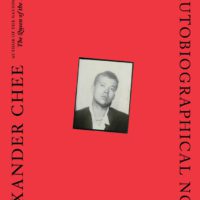Early on in Alexander Chee’s essay collection How to Write an Autobiographical Novel, Chee talks about the doodles he used to do when he was younger. Drawings for a staring eye, “the eye a perfect talisman for a boy who believed his watching both hid him and gave him power. Sometimes as I drew it, I was staring at myself,” he says. This is a perfect image to begin with because Chee is a watcher, an observer constantly on the outside looking in and developing an acute sensitivity that has enabled him to craft an earnest and moving essay collection about the relationship of art to one’s life and how they bleed into and influence one another.
The opening essay, “The Curse,” details Chee’s experiences as part of a high school exchange program where a group of American students live with host families in Chiapas, Mexico for the summer and take classes with the local students. However, unlike the Mexican students, they end up not having to take any classes. Chee uses the time to engross himself in stories (both in reading them and eventually writing his own). Writers and readers alike will find familiarity in this moment of turning to stories for something in life unfulfilled. In this particular essay, what’s unfulfilled is the desire to be seen and to be accepted for who he is—a gay, half white, half Korean American. In the essay Chee manages to pass, or “go native,” ending with Chee becoming ‘Alejandro from Tijuana” as part of a friendly bet to fool some of his host family’s friends during a wedding anniversary party. Chee manages to convince everyone of the deception, and he is able to pass largely because of his language fluency (thanks to his host family who refused to speak English to him again after the first night of his arrival), and in so doing, the essay calls attention to the artificial and arbitrary cultural boundaries that separate us. “The Curse,” then, becomes an essay about what it means to belong, and how sometimes others’ perceptions of whether you belong come from the way they see you. Chee is American, but in America, and in particular in Maine where he grew up, his identity is seen as “alien, or exotic, or somehow inhuman.” In America, he is made to feel he doesn’t belong because of how he looks, whereas in Mexico he is “only mestizo, ordinary at first glance.” Yet, as Chee points out by the end, this ultimately is a false sense of belonging. A bout of food poisoning reminds him that despite however much he’d passed, he was still an “imposter” who would never fully belong.
The second essay, “The Querent,” documents how Chee learned the Tarot. The origins of how Chee eventually came to the Tarot are interesting enough that they could have been their own essay (and as such I won’t reveal here), but they stem partly out of his love of stories (“much of what I love about literature is also what I love about the Tarot—archetypes at play, hidden forces, secrets brought to light”). Once again Chee is searching for something, only this time it is in whatever answers the Tarot can provide. Chee eventually becomes a professional Tarot reader and his insights on the profession are fascinating. Even within this essay, there are craft lessons to be given—Chee manages to imbue a craft lesson here about autobiographical writing. “We think this means this, and that means that,” Chee explains, “and in the meantime the true meaning is somewhere else, and the omen lies on the ground, face-down, as good as mute.” One must see outside of themselves with the appropriate distance, to be able to look at the events in one’s life with a level of detachment so as not to “cloud what is there with what you want to see.”
Not only are we told this lesson but Chee shows us this as well, because in the essay we get a glimpse of the first of several traumas that impact the course of his life. When Chee is barely a teenager his father gets severely injured in a car accident that leaves him paralyzed on one side of his body. Three years later his father dies from complications connected to his injuries. Echoes of the effect of these traumas permeate throughout as we move from Chee’s childhood to hearing about his experiences in college at Wesleyan University, his activism while living in San Francisco afterward, his life in graduate school, and then post-grad life while living in New York. Even though Chee writes about difficult subject matter, there’s enough emotional distance so that the essays never appear maudlin or overwrought. One could argue possibly that at times Chee is too distant in regards to some of the subject matter, but even here there is a reason for this—the distance mirrors Chee’s avoidance toward grappling with another trauma, one that happened to Chee as a boy and which takes the entire collection to be fully revealed. The effect then, once realized, is incredibly impactful, because by the end of the narrative we realize that much of this book is also about the process of healing from trauma that has in many ways shaped one’s life and one’s work.
Another essay of note is “After Peter,” a touching requiem written for painter and activist Peter D. Kelloran who died at the age of thirty-three from AIDS complications. Chee was, as he explains, a “minor character” in Peter’s overall story, but he is still able to create a heartfelt portrait of his life, composed through the collection of anecdotes from Peter’s friends as well as Chee’s own encounters, first seeing him when he visits the bookstore where Chee works and then later at subsequent protests with ACT UP, a collective of individuals involved in direct-action activism. The interactions we’re given between Peter and Chee feel like mere glimpses but still manage to be deeply affecting. Within the essay’s pages we get a scope of Peter’s life from those who knew him and it becomes an essay about the ripple one person’s life can have on another long after they are gone.
For those who’ve read any of Chee’s other books, the essays “The Writing Life,” “The Autobiography Of My Novel,” and “On Being An American Writer” will be of particular interest. These essays span his development and career as a writer which begin with him as an undergraduate taking a literary nonfiction class with Annie Dillard (which itself begins with a charming letter he’d written to her as part of his application) and follows his experiences completing his MFA at the Iowa Writers’ Workshop and subsequent post-MFA life trying to forge a writing career while working various waiter positions (including for the infamous William R. and Pat Buckley), as well as how he eventually came to write and publish his novels Edinburgh and The Queen of the Night. Throughout these essays, as Chee relays anecdotes from his mentors and teachers, he generously shares with us the most important craft lessons imparted to him. We also are offered peeks inside his own writerly process as he talks about his struggles writing and publishing his first two novels. In addition to these essays, there are two interspersed second-person point of view list essays, “100 Things About Writing a Novel” and “How to Write an Autobiographical Novel,” that read like writerly craft interludes. The experience of reading these pieces feels at times like being guided by a teacher, a mentor, and a friend.
About midway through the collection, in the essay “My Parade” detailing Chee’s time when he was a student at the Iowa Writers’ Workshop, he relays an experience with a fellow classmate who during a critique of one of his pieces, asks why he should care of stories about “the lives of these bitchy queens.” “I will make you care,” Chee vows to himself in response. Personally, it is difficult not to flinch upon reading about such a moment and not be reminded of all the ways writers from marginalized groups have had to prove their stories matter, but also, in a field where the cards continually feel as if they are stacked against them ever succeeding, most writers will have a moment where they, too, wonder why they should continue. Why should we even care about our own writing? What is the point of it when it seems as if every day the world continues to crumble just a little bit more?
Chee’s last essay, “On Becoming An American Writer” seeks to answer this question. “How many times have I thought the world would end?” Chee posits before sharing his memory of the day the Twin Towers fell. Then, like now, writers were faced with a sense of futility in continuing on with their work. “What is the point?” one of Chee’s students asked, a question many of us have wondered once again. It is a question I myself have often asked, but the effect of reading Chee’s essays is to be reminded of why we write, but also, why we read, even in these times of never ending distress. You don’t know who you can affect, who will connect with your work, who you can urge to keep going despite whatever trauma or grief or pain. To read this book is to be reminded that this is what the best of literature can do. It is such a gift, and I am grateful.




